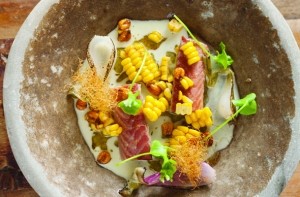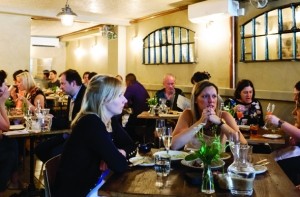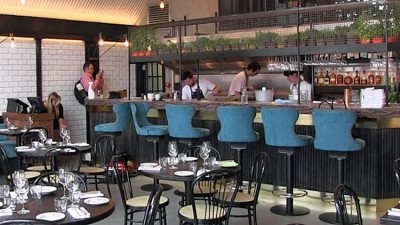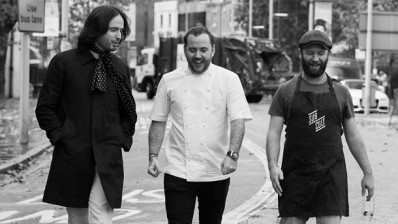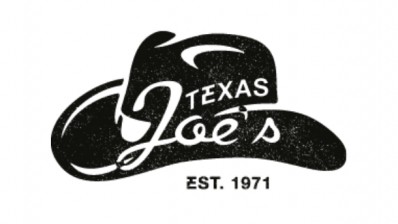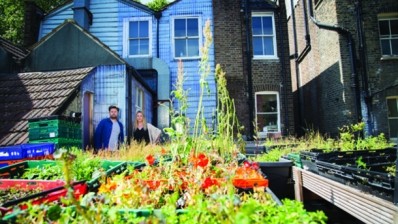How The Dairy became a cult hit
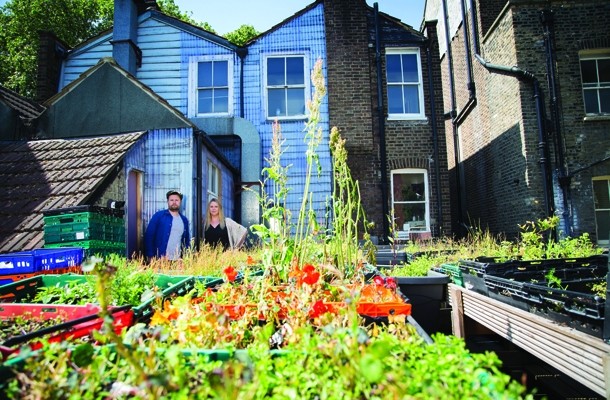
According to Raymond Blanc, Robin and Sarah Gill found love in the gardens of Le Manoir, their eyes meeting over a tray of micro-leaved sorrel (or something like that).
This isn’t quite how it happened but Monsieur Blanc – a famously hopeless romantic – must be granted a soupçon of poetic licence, especially as his comments were made to promote the Gill’s fledging business rather than market the aphrodisiacal qualities of his own Oxfordshire hotel.
The couple actually met at a staff party in their native Dublin a few months before they started working at Blanc’s famed establishment.
The Frenchman is one of a number of high profile industry figures to have championed this back and front of house team, who are now living the good life in south London.
Overlooking Clapham Common, The Dairy is the restaurant du jour for the capital’s off-duty chefs including Michel Roux Jr and Jason Atherton. After eating here it’s not difficult to see why. Brilliant creative food served with few airs and graces at a price that offers near unbeatable value – just £45 for the tasting menu.
The restaurant also emits an aura of unforced edginess that few other top-end places in the capital are capable of generating.
On the last Saturday of the month, staff from other restaurants descend on The Dairy after clocking off for a boozy meal cooked by a guest chef. Timed to coincide with payday, The Bloodshot Supper Club starts at 1am and runs until 7am.
Needless to say, it’s a rowdy occasion. In fact Sarah has been known to leave the country to avoid it, leaving Robin to run it in conjunction with Nuno Mendes of Chiltern Firehouse fame. Neither make any money from the event but sponsorship from local breweries keeps the drink flowing. Who said the era of the rock ’n’ roll chef was over?
The Dairy has been a smash hit with the critics too, attracting rave reviews across the board. It’s also just been ranked within the top 10 of Restaurant’s list of the top 100 places to eat in the UK.
Opened in mid-2013, the couple’s laid back restaurant retains the indie feel of a cult hit, but has been so successful a second restaurant, The Manor, has followed with a third set to open later this month.
Unusually, the Gills don’t employ a PR agency, but they are well-connected, media savvy and understand how to create a buzz – quite literally at The Dairy, which houses 80,000 bees within the hives on its roof.
Each restaurant has a USP. The Manor – which is located close to the pair’s inaugural restaurant in a less prominent location off Clapham High Street –has a dessert bar run by high-profile pastry chef Kira Ghidoni while The Dairy has a rickety yet beautiful urban garden.
“We overlook the Common so the idea was to create a farmhouse atmosphere in an urban area. I want people to feel like they’re in the countryside,” says Robin who, to the delight of The Dairy’s immediate neighbours, has replaced the shopping trolleys, rusty beer kegs and other assorted detritus that were on the roof with crates packed with nasturtiums and esoteric herbs.
Gardening duties
One roof’s worth of growing space is never going to yield enough produce to supply a whole restaurant, but it’s no gimmick. The team has chosen to focus on ingredients for garnishes and a handful of quick-growing vegetables. Some dishes are composed exclusively of homegrown and homemade produce, including The Dairy’s assemblage of courgette, basil, honey and fresh cheese, while the majority rely on produce from further afield.
Unlike Le Manoir, the brigade doesn’t have the luxury of a team of gardeners. Tending the garden is part of all the chefs’ work and on Tuesday lunchtimes the whole team is on weeding and repotting duty.
The Gills are still trying to work out if their garden should be classified as a smart business venture or a labour of love. “We have stuff growing up there that’s expensive to buy through a forager or specialist fruit and vegetable supplier. For example the sheep’s head sorrel we grow would cost us £80 a kilo. But, equally, there’s a lot of work involved. For me the main thing is that it’s an efficient use of the space,” says Robin, who also hangs homemade salamis in The Dairy’s cellar. An assortment of his team’s creations are sold in The Dairy’s adjoining deli, including surplus rooftop honey and an array of homemade jams, pickles and preserves.
Clapham, via Italy, Dublin and Oxfordshire
With a CV that includes Noma in Copenhagen and Southern Italy restaurant Don Alphonso, it’s no surprise that Robin is an expert at locating great ingredients. The Dairy and The Manor are focused on seasonal British produce but its sourcing policy isn’t rammed down diners’ throats.
“We don’t dump and run but we also don’t go through each ingredient on the plate and tell the diner where they came from as that can be quite tiresome,” says Sarah. “If people want that information we can go through it in detail, as it’s usually the chefs delivering the dishes.”
Robin arrived in London in the late 1990s armed with a Michelin guide and went round the restaurants listed until somebody gave him a job. That someone was Robert Reid, Marco Pierre White’s head chef at The Oak Room, which at the time held three Michelin stars.
“I was fresh off the boat and very short on skills, but I learnt quickly. Marco’s kitchens were renowned for being tough, aggressive places, but I loved it. If you got something wrong in service you’d get an absolute dicking, but by the end of it everyone would have their arms round each other. It was a family.”
After a few years he got homesick and returned to Dublin. Not a great move from the perspective of his development as a cook – he took a senior role and stagnated – but one he doesn’t regret as it led to him meeting Sarah at a staff party thrown by La Stampa.
Shortly after the two met, he headed to Southern Italy to learn the craft of handmade pasta at the side of an Italian mama. Sadly his fantasy of working in a rustic trattoria never became reality. Employment in such an establishment was not forthcoming and he had to fall back on his three-star experience to land a job at the renowned Don Alphonso in the bay of Naples.
“The chef used to rock up in a small van filled with artichokes or maybe aubergines. We’d just have to work with whatever was available that day,” says Robin, who clearly has especially fond memories of this period, not least because Sarah came to live with him there after finishing her studies. “The menus were shorter and the dishes were simpler than I was used to, but the food was incredible. The seafood was coming in still alive from the Med. We prepped the octopus while it was still moving.”
Upon leaving Italy Robin did a stage at Le Manoir but ended up getting a job there almost immediately as a demi chef de partie, leaving four years later as a sous chef to help Blanc launch a fine-dining restaurant at Arsenal’s Diamond Club. It was a job he hated despite his fondness for Blanc, or RB as he calls him.
He then spent four years as head chef of the D&D-owned Sauterelle, located on the mezzanine level of The Royal Exchange in the City overlooking the Grand Cafe. Given the independent feel of The Dairy, it’s difficult to picture him glad-handing bankers and toeing the line at a big corporate restaurant group.
While he says he doesn’t regret his time with the fine dining giant, he found the restaurant too stuffy and formal for his taste and was constantly trying – unsuccessfully, in the end – to persuade his employer to pull up the carpet and bin the table cloths.
A chance conversation with a friend then led to a short but lucrative private cooking gig in Mayfair that funded a six-month grand tour of restaurants and suppliers as the couple started to work towards opening their first restaurant.
“I’d worked with Matt Orlando [the US-born chef who now runs Amass in Copenhagen] at Le Manoir and he’d done something similar,” he says.
“I thought it was the most amazing idea. I studied cookbooks, ate in amazing restaurants and went to see suppliers.” But the bulk of this sabbatical of sorts was spent working unpaid at restaurants in
Scandinavia, most notably Franzén/Lindeberg (now just Restaurant Frantzén) in Stockholm and Noma, where the aforementioned Orlando was employed as executive chef.
“Everyone knew Scandinavian food was going to be the next big thing in cooking but I think few would have predicted quite how big and influential that part of the world would become.
The local and natural approach of René [Redzepi, the chef behind Noma] was groundbreaking and the simplicity of what they were doing just blew me away,” says Robin, who had a very different experience at Noma to most stagiaires because he already knew senior people in the kitchen including Orlando and the Irish-born Trevor Moran.
“I was one of the boys straightaway. I had my own section and my closeness with the team over those two months meant I got a good view of how it all worked. It was rock and roll, but serious at the same time. When a restaurant is that creative there needs to be a chaotic, disorganised element.”
Robin’s experience in Redzepi’s kitchen is detectable on the plate, but The Dairy is by no means a Noma clone. Other influences are evident, particularly those of Don Alphonso, and the menu is unapologetically eclectic. Some dishes reference Italian and French cooking, others are more resolutely British in style and a few contain Asian ingredients.
In common with a number of their peers, Robin and Sarah have taken from Noma the idea of bringing front and back of house teams closer together. “I’d always thought that an ‘us and them’ mentality was a bad thing, but seeing how it worked at Noma made me determined to do something about it,” says Robin. “Chefs bringing dishes out to the customer breaks down the barrier between the front and the back. At The Dairy, we also get our front of house staff involved with prep tasks. I totally nicked that idea from Noma.”
In the early days of The Dairy, having chefs serve the dishes also helped the Gills save on the wage bill. Budgets were tight and the business couldn’t afford many front of house staff. In fact in the beginning it was just Sarah and Damiano Fiammo (now a wine supplier and wine consultant for the group).
The Dairy's charm
The Dairy was, and to some extent still is, a low budget enterprise largely funded by family and friends. Money was incredibly tight at the beginning. Waiting until everything was perfect with the building before opening wasn’t an option. There was still work going on as the restaurant opened and the team had to do without essential bits of kit – including a combi-oven – until they had made enough money to afford a small kitchen extension.
“We needed to get cash going through the tills as quickly as possible. The kitchen crew that opened it built the roof garden while the builders were working on the dining room and we sanded down and varnished all the reclaimed furniture,” says Robin, as a bloke with a toolbox strides purposefully through the restaurant. “In fact we still haven’t quite finished.”
This is part of The Dairy’s charm. The restaurant is clean and professionally run but it’s got a refreshingly rough-and-ready feel for a place of such considerable gastronomic ambition. Crucially, not having to pay-off gold-plated handbag plinths or the fees of expensive restaurant design companies has allowed The Dairy to undercut its competitors both within its locality and further afield.
The Gills – who live down the road from The Dairy in Brixton – knew the owner of the site that would become their first restaurant, then accurately yet unimaginatively titled In Clapham. “It was always closed. It didn’t even open at the weekend, which was ridiculous in such a high footfall location. We suggested putting in some cash to refit the kitchen and sharing the profits with him,” says Sarah.
There was some interest but when the owner saw the business plan – specifically how much it costs to employ four skilled chefs – he got cold feet and offered to sell them his lease for a reasonable premium of £30,000.
The Dairy opened in mid-2013. Initially Robin and team offered larger more crowd-pleasing dishes – including mac ’n’ cheese and cassoulet – in tandem with more ambitious plates. “We thought the hearty stuff would be the big sellers but the market wanted something more involved, which was handy as that’s the sort of food we wanted to cook,” says Robin.
“There’s Trinity and Chez Bruce but there’s very little else at that sort of level,” adds Sarah. “There are a lot of people in this area with money that are quite happy not to go into town if there’s something good on their doorstep.”
A bargain tasting menu
The tasting menu started at £40 and has since risen to £45 following the addition of more courses – a total bargain given the quality of the team’s cooking and ingredients.
While the Gills agree that they could probably get away with charging more, they want to retain the low price point that has played such a crucial role in putting their restaurant on the map.
Raising the price of the tasting menu would also increase sales of the à la carte menu. About three quarters of the restaurant’s diners opt for the tasting menu, an impressive take up rate that the Gills want to maintain.
“I don’t want to start selling loads of a la carte as I don’t believe it shows our full range,” says Robin. “If I’m lucky enough to get some inexpensive turbot from my seafood guy I’ll put it on the tasting menu rather than à la carte because I want to drive people to a more complete experience of the restaurant.”
Robin might not quite hit a 70 per cent GP on his tasting menus, but his diners are spending more money and getting a more memorable experience, which drives repeat custom.
So why not scrap à la carte altogether?
“We want people to still be able to come in and have a plate of salami and some bread and a glass of wine. We’d lose a lot of our regulars if we suddenly became a tasting menu only place,” says Sarah.
Such a low price point requires Robin and team to shop smartly – they can only use luxurious ingredients when they can be purchased for a good price. Careful menu engineering also ensures the numbers add up with expensive dishes balanced by cheaper – but no less tasty – courses.
The restaurant’s unusually high volume – even with most people ordering the tasting menu, it still manages to turn a third of its tables on busy nights – also helps keep prices down. The six-strong kitchen team often does in excess of 80 covers in an evening service, which equates to 900 plates of food leaving the pass per service.
To the Manor born and beyond
The Manor was launched in November last year just eight weeks after the couple received the keys. Like The Dairy, it was opened on a small budget and the decor is simple and stripped back. Dean Parker – formerly Robin and Sarah’s head chef at The Dairy – instantly won over the critics attracting rave reviews from the likes of Marina O’Loughlin, AA Gill and Fay Maschler.
Much like The Dairy, the food and overall complexity of the menu was not what was first planned. The Manor was originally conceived as a more casual version of The Dairy with no tasting menu and bistro-style food. “Within a week we were serving a tasting menu,” says Robin, somewhat sheepishly. “Dean is ambitious and didn’t want to be stuck with just à la carte. I gave in very quickly and now we’re pushing
people towards the tasting menu just like we do at The Dairy.”
Later this month Robin and Sarah will open a third restaurant underneath the railway arches close to Bethnal Green tube station. Simon Woodrow, currently sous chef at The Manor, will man the stove with colleague Kira Ghidoni – who has gone down a storm at The Manor with her fun but precisely executed desserts – overseeing the sweet offering.
The cooking will be similar to The Dairy and The Manor but Robin says Woodrow – whose CV includes Arbutus – has a more overtly British and slightly more traditional style. Alongside a tasting menu and à la carte Paradise Garage will offer ‘picnic style’ sharing dishes.
Like The Dairy and The Manor the restaurant occupies the 60-cover “sweet-spot” favoured by the team. “It’s certainly the best space the group has secured yet. It’s going to look amazing and we can have a big open bar with counter seating that runs into an open kitchen, front of house and back of house will work side by side a bit like they do at Barrafina,” says Sarah.
The proximity of the bar to the kitchen is the inspiration for the East London restaurant’s USP – a big focus on food and drink matching that won’t be limited to just wine, with beer and spirit pairing planned too.
The name has been a matter of some contention. ‘Culture’ was a front runner in honour of the team’s affection for fermented items, but Sarah hated it and successfully campaigned for a less conceptual name –Paradise Garage – that references the restaurant’s location on Paradise Row.
This minor disagreement aside, the husband-and-wife team clearly enjoy working together and the adrenaline rush of running a young, fast expanding business.
“We had a different work schedule for years as I worked in events after Le Manoir so it’s nice to be working together,” says Sarah. “We’ve got different personalties, we’re both laid-back…”
“But I’m more highly strung,” Robin cuts in with a grin. “I will occasionally fly off the handle during service. If Sarah is there it’s a good thing, as she is very calm in any situation. She is a pacifying influence.”
Aided by the group’s general manager Dan Joines, Sarah oversees the front of house side of the business, but is working a little less following the birth of their first child, who arrived – conveniently – in September as the deli was opening and two months ahead of The Manor.
“I don’t do quite as many services as I’d like now, but I’m working in the restaurants every day,” she says. “I think we’ll look back on this year and last year and think ‘what an earth were we doing?’”
